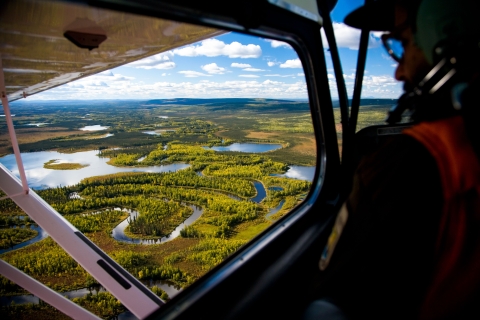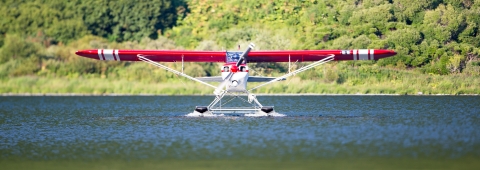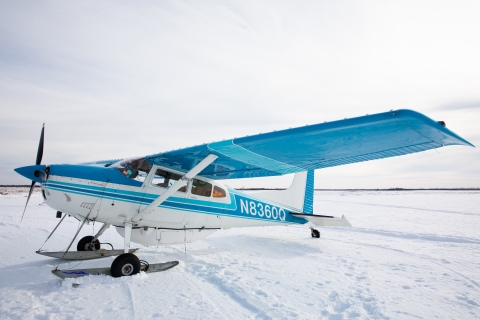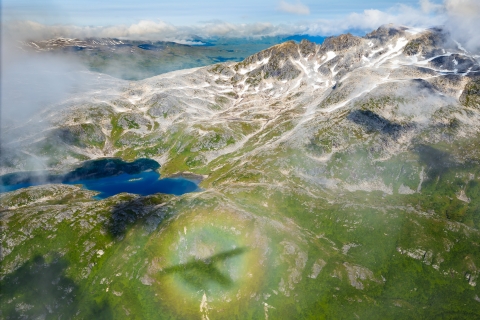Fly through mountain passes traversed by caribou, along braided rivers full of salmon, across a wide expanse of wetlands full of migratory birds... Your work as a pilot for the U.S. Fish and Wildlife Service in Alaska is critical to our mission, helping wildlife, habitats, and people thrive in this great land.
Alaska’s landmass is about one-fifth of the entire contiguous United States - but there are only about 15,718 miles of public roads. Air travel connects communities across an enormous landscape, and is the largest aviation system in North America.
Read more to learn about ways to join our team for a unique aviation career that could take you to amazing places.
How we fly
Alaska is a vast landscape with few roads. The work of the U.S. Fish and Wildlife Service takes us to the farthest corners of the state, from the Arctic to the Aleutians. We use aircraft, mostly fixed-wing, single engine planes, much as a vehicle or tool to conduct our field operations, including:
- waterfowl and migratory bird population surveys
- low level surveys and radio tracking large mammals
- law enforcement surveillance
- fire reconnaissance
- flights to drop off and pick up crew and supplies in remote field camps.
The Alaska region employs the greatest number of pilots in our agency, some of the most unique and specially trained positions in the conservation profession. These positions range from full time pilot positions to “dual function” biologists, law enforcement officers, and special agents who fly.
Whichever path your aviation career with us takes, it is important that you love to fly small planes. Each position requires time and interest to meet the full requirements of either a dedicated pilot or a dual function pilot biologist or law enforcement pilot. If you love wildlife and aviation, exciting opportunities await!
Our Fleet
We fly a variety of different fixed-wing aircraft configured multiple ways, depending on what is required to complete the mission objectives and maximize safety. The Alaska fleet consists primarily of single-engine and turbo-prop aircraft modified to maximize performance and carry externally mounted equipment. Our aircraft can be configured on tundra tires, floats, amphibious floats, skis or retractable wheel skis, or normal (small) tires.
We currently operate the following aircraft in Alaska:
- Cessna 206 F, G, and H model Stationair
- Cessna 185F Skywagon
- Cub Crafters CC18-180 Top Cub
- Pacific Aerospace (formerly Found) FBA2C Bushhawk
- de Havilland DHC2 Beaver
- Daher (formerly Quest) Kodiak 100
- Partenavia P68
Our Pilots
Pilot Biologist
(Job Series GS-0401, 0482, or 0486)
Flying for the National Wildlife Refuge System in Alaska as a dual function pilot biologist
The National Wildlife Refuge System conserves habitat and wildlife at over 560 refuges nationwide. Alaska has 16 National Wildlife Refuges located across the state, and refuge pilot biologists are typically stationed within the main community adjacent to the refuge.
Pilot biologists in this program vary from generalist wildlife biologists to more specialized disciplines, such as bear biologists, mammal biologists, fish biologists, botanists, ecologists, etc. They use aircraft as a tool or vehicle to conduct field work in remote places that are not accessible by vehicle or boat.
Some of the field work that refuge pilot biologists perform include wildlife (e.g., moose, bear, caribou, waterfowl) surveys, tracking animals with radio-telemetry, and flying into remote refuge locations to conduct plant, water, and other ecological studies. Refuge pilot biologists may also support field operations for other projects within the refuge, including remote camp logistics.
Flying for the Migratory Bird Management Program as a dual function pilot biologist
Pilot biologists in the Migratory Bird Management Program are stationed throughout the United States, and in Alaska they are stationed in Anchorage. These employees are responsible for monitoring waterfowl population trends and distributions for the purposes of establishing harvest regulations, conducting waterfowl status assessments, and conserving waterfowl habitat.
The dual functions of biologist and pilot challenge the employee to take direct responsibility for data collection protocols and presentation of results and also serve as pilot-in-command on low level aerial waterfowl survey missions, including pre-mission planning and logistics, adherence to survey protocols, and post-survey briefings.
New pilot biologists typically go through a period of 1-3 years of training prior to taking over full responsibility for data collection and piloting roles.
Meet a team of Alaskan biologists on an annual goose roundup to discover how teamwork and a unique use of float-equipped aircraft can get the job done.
Law Enforcement Pilot
Federal Wildlife Officer/Pilot at National Wildlife Refuges (Job Series GS-1801)
Federal Wildlife Officers (FWOs) are first and foremost law enforcement officers who use aircraft as a tool to perform their duties, which include investigation, apprehension, arrest, detention, or prosecution of people who violate laws, rules, and regulations enacted to protect and provide for the safe use of lands managed by the U.S. Fish and Wildlife Service. These positions work within the National Wildlife Refuge System. In Alaska, FWOs are stationed in Anchorage, Fairbanks, and various small communities adjacent to Alaska’s 16 National Wildlife Refuges.
Special Agent/Pilot for the Office of Law Enforcement (Job Series GS-1811)
Special agents are federal law enforcement officers who conduct investigations, make arrests, execute federal search warrants, and serve subpoenas. Special agents focus their enforcement efforts on unlawful commercialization of wildlife and protection of sensitive species and habitats. Special agent pilots support enforcement operations by providing personnel transport, logistical support, and conducting aerial reconnaissance. Currently, special agent pilots are stationed only in Alaska.
Pilot or Instructor
Single-Function Pilot (Job Series GS-2181)
Single-function pilots fly full time as their job duty. They support a variety of field operations, including dropping off and picking up field crews, supplies and equipment; conducting wildlife surveys and radio-telemetry; and assisting law enforcement officers with surveillance and patrol. Single function pilots are currently located in Anchorage and Fairbanks.
Airplane Flight Instructor
This Anchorage-based position serves as the Alaska Regional Aviation Trainer to oversee the fleet pilot training program. They develop aviation training policies, standards, methods, guidelines, and procedures for the agency’s training program. Additionally, the instructor develops regional pilot training syllabi and lesson plans for specialized resource flight missions and assists the Regional Aviation Manager and other bureau representatives to plan, schedule and conduct flight clinics for specialized types of flying such as float, ski, instructor, resource, off airport, and glacier clinics.
How to fly for us
“Keep at it. Keep your eye on the prize. It’s a long road, but we need you. It takes a lot of work and some investment, but it will pay off.”
- Nikki Guldager, Pilot Biologist at Yukon Flats Refuge
Many of our pilots get started flying on their own to obtain the foundational FAA pilot certifications, private pilot certificate, commercial pilot certificate, and instrument rating, and build up their hours (to 500 or 1500 hours, depending on the position).
Mentorship and Training Opportunities in Alaska
We offer a mentorship and training program for new pilots to meet qualifications required to fly an array of natural resource specialized missions. Additional training may include: low level wildlife surveys, animal radio-tracking, aerial remote sensing, law enforcement patrols, off-airport landings, and multiple aircraft configurations (wheels, skis, floats, amphibious floats).
The Alaska Region has a Regional Aviation Trainer who develops and oversees all fleet pilot training. We also have many experienced fleet pilots who serve as Instructor Pilots in addition to their normal dual-function and/or piloting duties to assist in specialized flight training. External flight schools may also be utilized to provide specialized aviation skills such as Upset Recovery Training, off airport training, and mountain survey flying.
Apply on USAJobs.gov
All U.S. Fish and Wildlife Service job opportunities are announced on USAJobs.gov. Check OPM.gov for specific job listing qualifications.
Tip: you can set up email notifications for specific job series, and search for positions within specific locations.
Aviation qualifications
To qualify for a dual-function pilot position, the successful applicant must meet the job requirements in their position of interest (biologist or law enforcement), AND:
- possess a current Federal Aviation Administration (FAA) Commercial Airman Certificate with rating appropriate for the duties performed;
- possess an instrument rating, and 10 hours as Pilot-in-Command in actual or simulated instrument flight rules conditions;
- have completed a minimum of 500 hours of flight time as Pilot-in-Command;
- have completed 25 hours as Pilot-in-Command at night; and
- possess a current Class II FAA Medical Certificate.
- Single Function Pilot Requirements
Single-function full time pilot position requirements are the same as above with the exception of a 1500 flight hour requirement as opposed to 500. This position does not have an education qualification requirement.
Pilot Biologist
Pilot biologists must meet federal qualification standards for both education as a general biologist or wildlife biologist, AND the minimum aviation qualifications to qualify for a dual function pilot biologist position.
For more information about education requirements, training, and qualifications: Becoming a Pilot Biologist for the U.S. Fish and Wildlife Service.
Law Enforcement Pilot
To qualify for a uniformed Federal Wildlife Officer Pilot (GS-1801), candidates must successfully complete an arduous 17-week course at the Federal Law Enforcement Training Center, five weeks of advanced officer training at the National Conservation Training Center, and 10 weeks of Field Training and Evaluation.
Special Agent Pilot (Office of Law Enforcement): At minimum, candidates must meet the entry requirements for the GS-1811 criminal investigator position. Both education and prior employment will be considered when applying for an agent position. In addition, selected applicants will be required to successfully complete the Criminal Investigator Training Program at the Federal Law Enforcement Center, Office of Law Enforcement Special Agent Basic Training, and the Field Training and Evaluation Program.
For both law enforcement positions, a college degree is not required to qualify, but applicants will be more competitive with a degree in biology, natural resources (fish, wildlife, ecology, etc.), or criminal justice or a similar field.
More resources
U.S. Fish and Wildlife Service Aviation Program
Contact Alaska Regional Aviation Manger: Nate Olson








